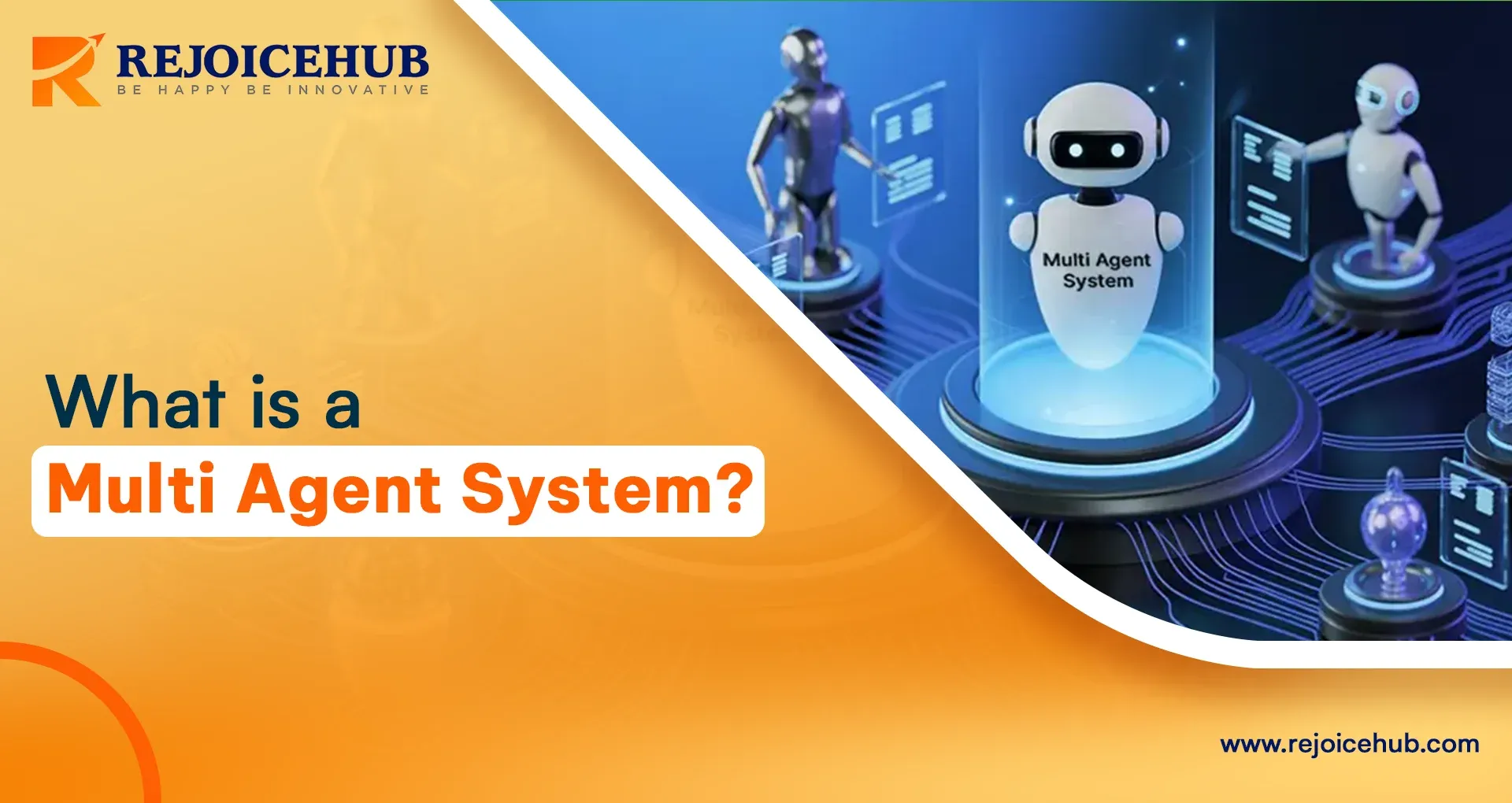
You must have seen a perfect team in sports or a group of friends taking the food in a very sequenced group. Just like me, you too must have thought about why this concept is not used in complex problems. Actually, different work requires different software, and integrating all of them is sometimes quite frustrating.
In 2025, as AI and generative AI have evolved, this sequence concept has been used in the design of Multi-Agent Systems (MAS). Due to AI agents, 70% of loan risk in the financial sector is reduced, and the speed of credit scoring also increases.
As an AI expert, I have looked at Multi-Agent Systems very closely, in which it has transformed industries, be it healthcare or transportation, a lot. When you allow multiple intelligent agents in your work, they can collaborate, compete, and adapt in complex environments. Unlike traditional AI models that handle everything alone, MAS thrives on teamwork, specialization, and scalability.
By the end of this article, you’ll know exactly what MAS is, how it works, its architectures, structures, types, best practices, use cases, advantages, and challenges.
Quick Summary
A Multi-Agent System is a framework where multiple autonomous agents, which could be software programs, robots, or even drones, interact within an environment to achieve individual or shared goals. Multi AI Agents are widely used in healthcare, defence, smart transportation, supply chains, and gaming.
MAS can solve large-scale, complex problems more effectively than single-agent systems. Advanced and large industries are replacing single AI agent systems with multi-agent systems so that different operations can be made smoother and specialized. Due to the importance of MAS for so many industries, Northwestern University of USA has also developed a course on Multi-Agent Systems.
Our Focus in this article:
1. What is a multi-agent system, and how does it work?
2. In which sectors is the multi-agent system used, and what are the benefits of it?
3. How can you deploy AI agents in your industry, and what things should you keep in mind while deploying them?
What is a Multi-Agent System?
If we understand the Multi-Agent System (MAS) in simple terms, then you can call it a network of independent agents that can autonomously sense the entities of the environment and make decisions accordingly and achieve their goals. These agents can be simple chatbots or even complex agents like self-driving delivery robots.
When I deployed the multi-agent system for my logistics clients, I was amazed to see it working because each agent was specialized in their roles, and hence one agent was handling inventory, another was managing routing, and another was forecasting demand. The multi-agent system gave much better results compared to single agents.
Core components of MAS:
1. Agents: AI agents can be considered the brain of your software that handles the whole system, and in multi-agent systems, each AI agent has specific skills, knowledge, and goals.
2. Environment: For AI agents, any external environment is where they apply their operations in the physical world. Examples of the physical world are AI agents used in (factories, roads), and the best example of a virtual environment is (cloud platforms).
3. Interactions: When AI multi-agent systems communicate, cooperate, or compete with each other, it is called "Interactions" in AI operations.
4. Communication protocols: The accuracy and ROI of any multi-agent system depend on its communication protocols, because if the communication between AI agents is not good, they can interfere with each other's work. Therefore, AI agents use shared languages or APIs that help them exchange information.
The core requirement of any AI agent depends on its interaction. In any well-designed MAS, agents can negotiate, share knowledge, adapt, and even sometimes form temporary alliances to solve bigger problems in any business operations.
How Do Multi-Agent Systems Work?
Whenever a client asks us how Multi-Agent Systems work, I tell them that multi-agent systems can be thought of as highly organized remote team members. All AI agents have autonomy, but they coordinate (communicate) with each other through meetings, share files according to the environment and make decisions (rules of interaction) according to the project or operations.
Let's understand the typical workflow of a multi-agent system.
1. Perception: All AI agents observe their environment, and for this, they use sensors and input data. Perception can be considered as the first process of the AI agents, on the basis of which further processes will be implemented.
2. Decision-making: Any AI agent decides what action should be taken based on the business goals and available data. Some AI agents depend on user input and take decisions according to the input, but some autonomous AI agents, like a self-driving car, take automatic decisions.
3. Interaction: AI agents can communicate with different AI agents and software, and can share information with AI agents and company staff. Advanced AI agents can request and negotiate according to the resources.
4. Action: AI agents plan decisions based on perception and interaction and execute the plan in the environment accordingly.
5. Learning: Mostly, AI agents are trained from generative AI databases, due to which AI agents have the capability to gain knowledge according to the outcomes and plan strategies accordingly.
This is why companies like ChatGPT and Google train their staff as skilled high-edge AI agents, so that they can give manual input and prompt according to any error or strategy.
Multi-agent systems can be centralized so that a master agent can properly coordinate and make all decisions, or decentralized agents can act independently but still share information.
Architectures of Multi-Agent Systems
Multi-agent systems (MAS) are a type of autonomous network of agents that interact with each other to accomplish individual and collective goals. The architecture of any AI agent defines how the AI agents will communicate with each other, how they will make decisions, and how they will share responsibilities. Currently, the two most common architectural models used are decentralized and centralized networks. Each comes with its own strengths, weaknesses, and suitable use cases.
1. Decentralized Networks
In decentralized architectures, there is no single authority or central controller that can manage the agents. In this, AI agents communicate with neighbouring agents based on local information and make decisions accordingly. This network emerges based on the interaction of all agents.
Key Characteristics
- Peer-to-peer communication: All AI agents interact with each other on the basis of equal terms.
- No single point of failure: The biggest advantage of multiple AI agents is that even if some agents fail, the rest of the agent system continues to function.
- Emergent behavior: AI agents make local decisions and achieve global outcomes based on information.
Benefits
- High robustness and fault tolerance: As we know, even if an agent fails, the rest of the AI Agents handle their operations without a system-wide collapse.
- Scalability: Whenever a business needs to add an AI Agent for a new operation or scalability, it can do so easily due to the AI Agent without major restructuring.
- Adaptability: AI Agents react quickly in dynamic or unpredictable environments.
Drawbacks
- Complex coordination: If AI Agents do not have a central controller, it will be much harder for them to achieve global goals.
- Slower convergence: It may take more time for an AI agent to reach consensus or agreement among all agents.
- Local decision bias: If AI agents are not trained on a large model, they may act according to their own interests, which does not guarantee a global outcome standard.
Example Use Case
For California 2025 wildfire disaster management: A large number of drones were used to analyze and control wildfires in California, to locate survivors and to update current fires. AI agents deployed to drones also have the capabilities to map the fire terrain and control the fire.
2. Centralized Networks
In the architecture of a centralized network, a single central controller or leader agent coordinates and handles the activities of other agents. All AI agents send information to their controller or leader AI agent so that it can make decisions accordingly; most decisions are controller-backed.
Key Characteristics
- One leader, many followers: In a centralized network, the controller or AI agent is the brain of the system that controls all other agents.
- Top-down communication: All other AI agents rely on the central unit for all commands and decisions.
- Uniform decision-making: Controller or AI agent leaders always ensure that the system maintains consistency in decisions and flow.
Benefits
- Simpler coordination: Centralized Networks depend on a single controller, and that leader manages all the decisions, so other AI agents do not have to negotiate with each other.
- Uniform decision-making: The controller ensures that harmony is maintained among all agents so that conflicts among AI agents can be reduced.
- Quicker setup: Centralized network architecture is suitable for small or medium-sized systems where centralized management is considered efficient.
Drawbacks
- Single point of failure: If a controller or an AI leader agent fails, the entire system may fail, causing the entire operation to be disrupted.
- Limited scalability: If the number of agents is increased, there is more pressure on the controller, which can have a significant impact on scalability.
- Reduced adaptability: Centralized controls react slowly to sudden, localized changes.
Example Use Case
Smart Traffic Management: Google maps and many countries use traffic control sensors and cameras to update the current traffic of the city and use AI agents to control traffic lights, or to optimize vehicle flow so that road congestion can be reduced. Although this is quite useful, if the AI controller server fails, the entire system may fail to function.
Structures of Multi-Agent Systems
The structure of a multi-agent system defines how agents are arranged and organized and how they interact with one another. Unlike architectures (which describe communication and decision-making patterns), the structures that form it focus on the organizational design, i.e. how they distribute their responsibilities among themselves for managing the system.
Multi-agent systems have several well-known structure designs, which include holonic, hierarchical, team-based, and coalition-based approaches.

1. Holonic Structure
In a holonic structure, agents are organized into holons, which are units that function both as independent entities and as parts of a larger whole. These holons form a holarchy, in which all levels are made up of smaller holons, and all of them are part of a bigger system.
Key Characteristics
- Dual nature: All holons are autonomous but they are subordinate to larger holons.
- Recursive structure: In this, smaller units form bigger ones, which together form the entire system.
- Flexible organization: Holons are very flexible, so you can easily reorganize them in a dynamic form.
Benefits
- High modularity: In this, the system can be broken down into smaller units, which are also manageable.
- Fault Tolerance: If there is a problem in any one Holon or even if any Holon fails, it will not affect the rest of the system.
- Scalability: You can add new Holons in a Holonic Structure without disrupting the overall system.
Drawbacks
- Complex management: Balancing autonomy and cooperation among agents can be difficult at different levels.
- Communication overhead: As holarchies grow in a Holonic Structure, coordination among holons becomes more complex.
Example
Manufacturing Systems: In a factory, all production units (holons), such as assembly, packaging, or quality control agents, work independently. But they all contribute to a larger goal of producing goods.
2. Hierarchical Structure
A hierarchical structure organizes AI agents in a top-down sequence that resembles a corporate organization chart. Higher-level agents supervise and control lower-level agents.
Key Characteristics
- Clear chain of command: Agents at all levels are dependent on directives from above.
- Well-defined roles: AI agents are assigned specific responsibilities or tasks at all levels and work accordingly.
- Centralized oversight: Higher-level AI agents ensure coordination with all subsystems.
Benefits
- Easy to manage and understand: As we know, in the hierarchical structure, all the responsibilities of AI agents are clearly defined.
- Efficient decision-making: Higher-level AI agents always ensure that coordination is maintained so that conflicts can be reduced.
- Predictable behavior: Advanced AI agents keep the flow of auctions in a controlled and structured manner.
Drawbacks
- Single point of failure risk: If failure occurs at higher levels, the entire system can be disrupted.
- Reduced flexibility: Hierarchical structure is slower than decentralized models, and it adapts slowly to sudden changes.
- Bottlenecks: If AI agents are dependent on higher-level AI agents, their performance can slow down.
Example
Defense Systems: Command agents can give automatic commands to surveillance agents, and these AI agents can control lower-level sensor agents. This creates an extra layer in the military-style chain of command.
3. Teams
Team structure: AI agents work together consistently as a part of a stable group. All AI agents share common goals, and for this, they divide the tasks and are dependent on each other's output to complete the objectives.
Key Characteristics
- Shared goals: In the team structure, all AI agents work for the same purpose. And this also makes it possible to achieve the goals.
- Strong interdependence: In team agents, all AI agents are dependent on each other, and the performance of all AI agents is also affected by the rest of the team.
- Stable grouping: The working of a team which consists of AI agents is quite stable, and it remains stable even for long periods, due to which the workforce remains quite smooth.
Benefits
- High collaboration: When AI agents work together, they are able to work more speed and due to this they are also able to achieve the goals quickly.
- Efficient problem-solving: As we know, when AI agents work with teams, it is quite easy to tackle complex tasks.
- Strong adaptability: AI agents adjust to internal roles according to changes in the team structure. Team AI agents have strong adaptability capabilities.
Drawbacks
- Over-reliance: The problem with Team AI agents is that if any AI agent underperforms, the entire team can suffer.
- Coordination cost: Team AI agents require strong synchronization for communication.
- Scalability issues: If there are too many AI agents in a team, the team may face inefficiency.
Example
Search-and-Rescue Robots: A group of robots can form a permanent team to search disaster areas, and these AI robots can easily scan terrain areas, and some robots can assist survivors and even supply them with food.
4. Coalition Structure
Coalition structures form alliances for a temporary time period to handle specific problems or goals. And when the objective is achieved, AI agents disable the coalition and return to their independent roles.
Key Characteristics
- Dynamic alliances: AI agents form groups as per the needs and dissolve the group after the work is done.
- Short-term cooperation: Coalition structures are focused on specific tasks or challenges, and form short-term cooperation as per the work and then dissolve their team.
- Flexible membership: It is also possible that AI agents belong to different coalitions and that, too, for different tasks.
Benefits
- High flexibility: The coalitions in which agents are a part form groups only when they have a requirement, so that they can reduce overhead.
- Efficient use of resources: AI agents form groups to temporarily bring the capabilities of other agents to the table, thus maximising impact.
- Adaptability: coalition agents work well in unpredictable environments and have strong environmental adaptability.
Drawbacks
- Unstable relationships: Temporary alliances reduce trust and reliability, as agents' expertise in a coalition structure is limited to a short period of time.
- Coordination challenges: AI agents have individual goals beyond coalitions, and agents may conflict over them.
- Overhead in formation/dissolution: When agents form coalitions, it takes a lot of time, and it also takes a lot of time to break alliances.
Example
Warehouse Robots: Companies like Amazon use AI agents to form coalitions during peak demand so that they can manage workloads. And as demand decreases, AI agents return to individual operations.
Comparison Table: MAS Structures
| Structure | Organization Style | Best For | Weakness |
|---|---|---|---|
| Holonic | Recursive “whole-part” units | Modular, scalable systems | Complex coordination |
| Hierarchical | Top-down chain of command Defense | Defense, corporate systems | Central failure risk |
| Teams | Stable group of agents | Long-term collaborative tasks | Over-reliance on team members |
| Coalition | Temporary alliances | Dynamic, unpredictable problems | Instability & coordination overhead |
Types of Multi-Agent Systems
We know a lot about multi-agents, let us now learn about the stems of different multi-agents.

1. Cooperative MAS: These are AI agents that work towards the same goal and can also share the same resources.
2. Hierarchical MAS: In this, AI agents are arranged in layers according to their authority and job roles.
3. Competitive MAS: Its agents have capabilities such as conflicting goals, competing for resources.
4. Heterogeneous MAS: These are AI agents that have different skills and knowledge, and they use that knowledge together to bring flexibility in work.
All AI has its own capabilities, and it all depends on your work which AI agent you will choose. From my practical experience, I would advise you to use Cooperative multi-agent systems as they are much more stable.
Best Practices for Multi-Agent System Implementation
Building a multi-agent system (MAS) does not mean designing intelligent agents but rather ensuring that they work together efficiently while maintaining safety and adaptability. Let me use my practical personal experience to guide you in successfully implementing multi-agent systems.
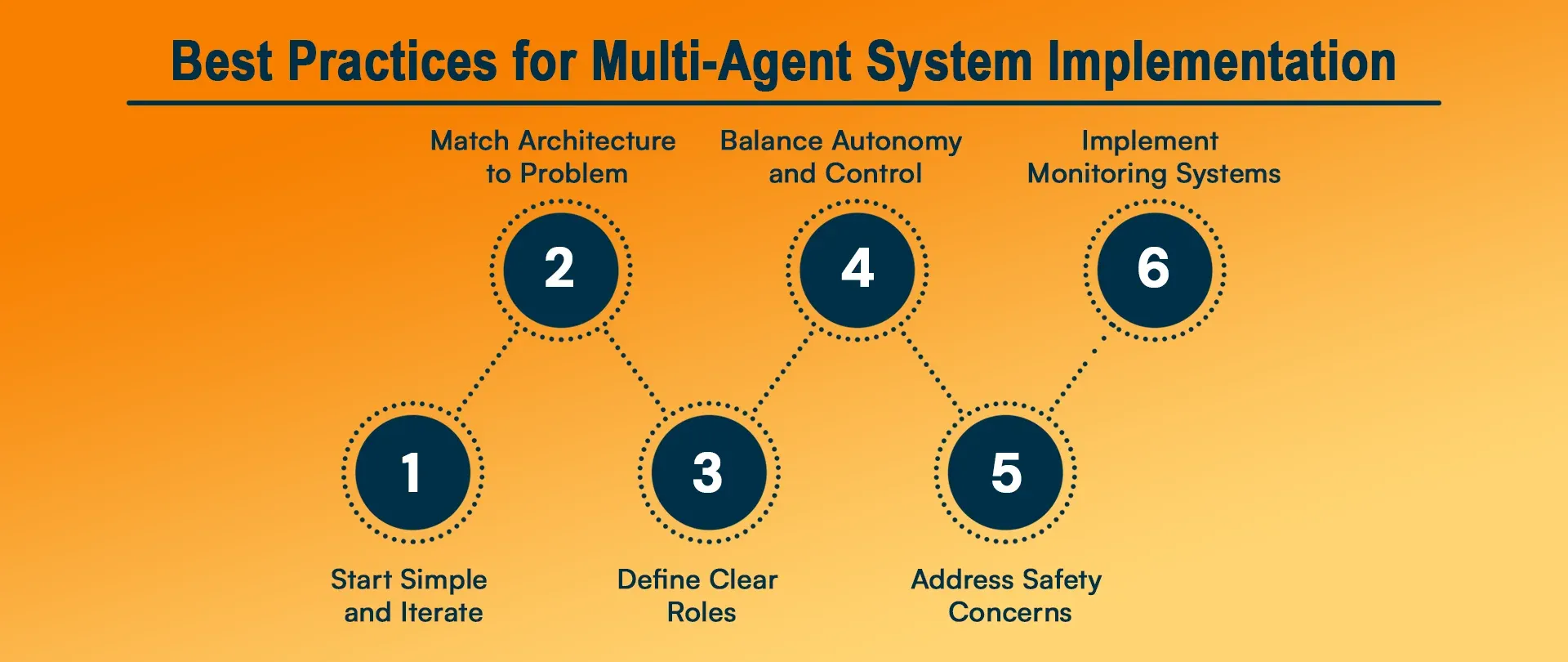
1. Start Simple and Iterate
Whenever you design a MAS, it is not necessary that you design a large, complex system, as complex designs may encounter unexpected interactions and failures.
Best Practice: Whenever you start designing AI agents, deploy them with a small number of AI agents so that you can handle them easily. Gradually introduce new agents, roles, and behaviours according to business operations and validate performance. This helps in early detection of flaws and also helps in reducing complexity.
2. Match Architecture to Problem
Different problems demand different multi-agent system structures. If you set them incorrectly, you may have to face inefficiency or failures.
Best Practice: Whenever you use decentralized networks, adaptability and resilience are very crucial.
You should use centralized networks when coordination and uniformity are most important to you. (eg. traffic control)
3. Define Clear Roles
Role ambiguity can create redundancy and inefficiency, and with AI agents, you can assign different responsibilities to different AI agents.
Best Practice: Whenever you deploy AI agents, keep the roles of all AI agents clear and non-overlapping. Define who collects data, who processes it, and who acts. This reduces conflicts between AI agents and improves coordination.
4. Balance Autonomy and Control
Giving AI agents too much autonomy can create chaos; you may have to face uncoordinated behaviour, and too much AI agent control can make the system rigid and unresponsive.
Best Practice: Design AI agents that can maintain balance and make local decisions independently, but still follow global rules and supervisory guidance.
5. Address Safety Concerns
Pay special attention to safety when deploying a multi-agent system, especially for real-world applications, such as healthcare, defence, or transportation.
Best Practice: It will take extra time to implement AI agents, but always keep in mind that the mechanisms of AI agents should be built to be fail-safe. So that in case of any emergency, the mechanism stops automatically. And keep in mind that the failure of one agent should not cause the entire system to collapse or compromise.
6. Implement Monitoring Systems
If you do not monitor AI agent systems, it can lead to unexpected errors and issues in the MAS, and it can be difficult to detect problems in the long term.
Best Practice: For this, you can use monitoring tools to track performance, detect anomalies, and log behaviours. By monitoring AI agents, you can fix errors and optimize your system, and this also enhances the trust in your system.
Advantages of Multi-Agent Systems
Multi-agent systems provide unique benefits, and multi-agents have many more advantages than single-agent or centralized systems.
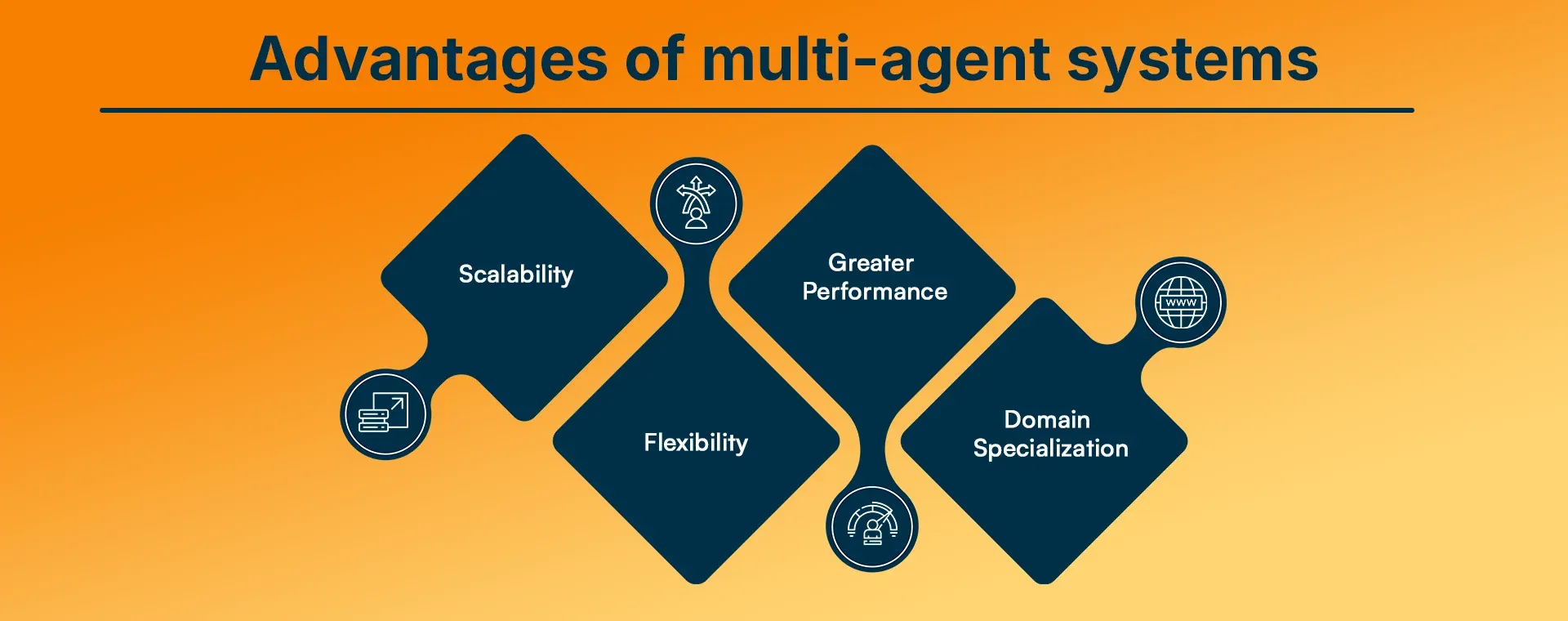
1. Scalability
Multi-agent systems can easily grow according to demand. In this, you can easily add or remove new agents, that too without making changes to the entire system.
Example: A cloud-based MAS dynamically scales servers during peak hours according to demand, which reduces pressure on the platform.
2. Flexibility
AI agents can adapt themselves according to environmental changes or new goals, and that too without shutting down the entire system.
Example: Disaster agents can rescue survivors while exploring the terrain, and they can easily shift their goals.
3. Greater Performance
Today, agents execute tasks in parallel and solve MAS problems faster than centralized or single-agent systems.
Example: In the logistics business, one agent plans routes and the other agents simultaneously load, and other agents help in transportation and package delivery.
4. Domain Specialization
In a multi-agent system, all AI agents are specialized in a specific area. And all AI agents are given the role of their respective area so that they can strongly contribute to the system with their domain-specific knowledge.
Example: In the healthcare sector, in a multi-agent system, one agent monitors the patient's vitals, another analyzes the patient's lab results, and the third AI agent can suggest the next treatments to the doctors.
Use Cases of Multi-Agent Systems
Today, Multi-agent systems are being widely used in different industries because they provide very effective scalability, adaptability, and parallel problem-solving capabilities. Let us learn about some important use cases of multi-agent systems.
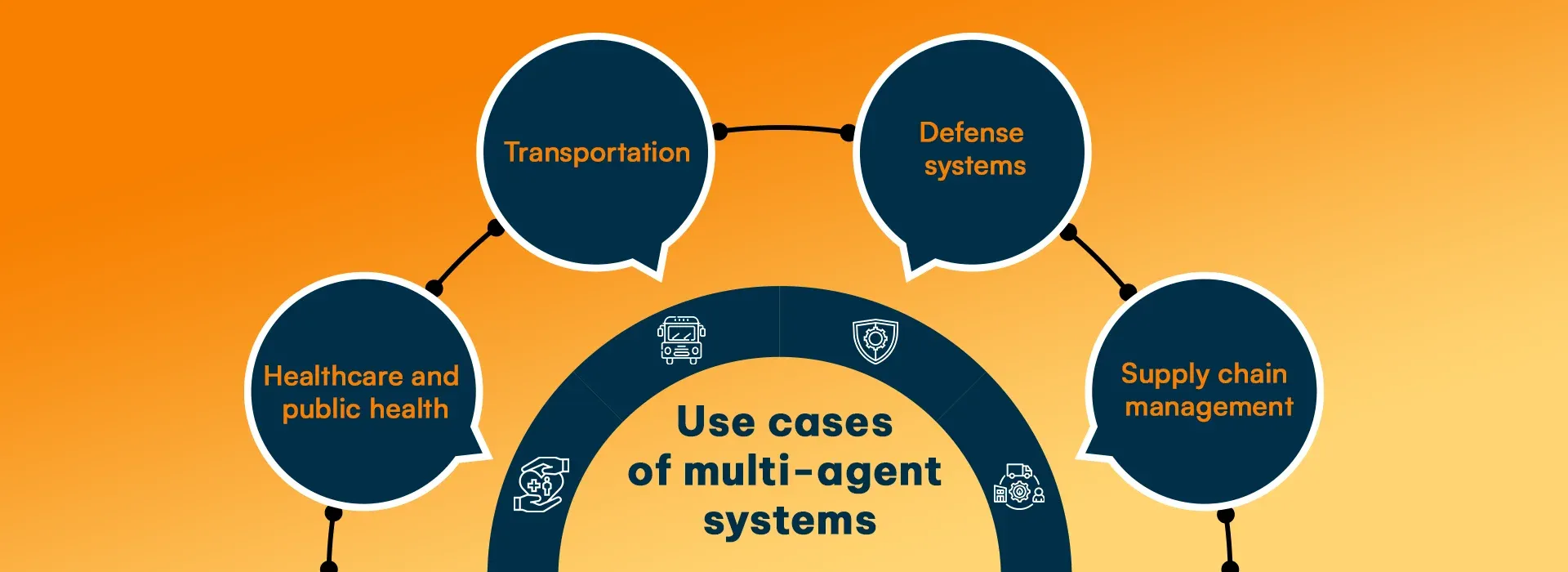
1. Healthcare & Public Health
As we know that the healthcare sector is very critical and efficient coordination between doctors, hospitals, patients, and policymakers is very important in the healthcare sector. A multi-agent system can easily handle complexity by using its intelligent system and distribute decision-making for it.
Applications
- Disease Prediction and Prevention: MAS Agents use patient data, social trends, environmental factors, and symptoms to predict exactly what problem a patient may have.
- Coordinating Hospital Resources: AI agents further optimize hospital bed allocation and can better schedule staff time and handle medical equipment usage in real time.
2. Transportation
Modern transportation systems rely on real-time coordination of vehicles, traffic lights, and logistics hubs. Multi-agents are very popular in cities like Singapore to make cities smarter, safer, and more efficient.
Applications
- Optimizing Traffic Lights: Central or decentralized MAS can dynamically adjust signals based on live traffic flow.
- Coordinating Autonomous Vehicles: Autonomous cars use multi-agents to communicate with other systems so they can avoid collisions and maintain safe distances from other vehicles.
3. Defense Systems
Military and defence operations involve complex decision-making, rapid responses, and secure coordination, and multi-agent systems play a very important role in this. Multiple agents can simulate and act quickly in high-risk scenarios.
Applications
- Monitoring for Cyberattacks: Security agents continuously scan the network so that they can detect unusual patterns and collaboratively respond to threats.
- Simulating Military Strategies: Virtual agents can simulate battlefield conditions to understand real war conditions and formulate strategies accordingly.
4. Supply Chain Management
As we know, global supply chains are highly interconnected and dynamic. Multi-systems improve efficiency and help in real-time negotiation, maintaining coordination, and automation.
Applications
- Automating Procurement, Inventory, and Logistics: AI Agents can easily handle supplier orders, stock monitoring, and shipment routing.
- Negotiation Between Suppliers and Distributors: AI agents represent companies and can negotiate pricing, manage delivery schedules, and share available resources.
Challenges of Multi-Agent Systems
The Multi Agent system has as many challenges and drawbacks as it has advantages. Since MAS is still evolving, it can also face many issues.
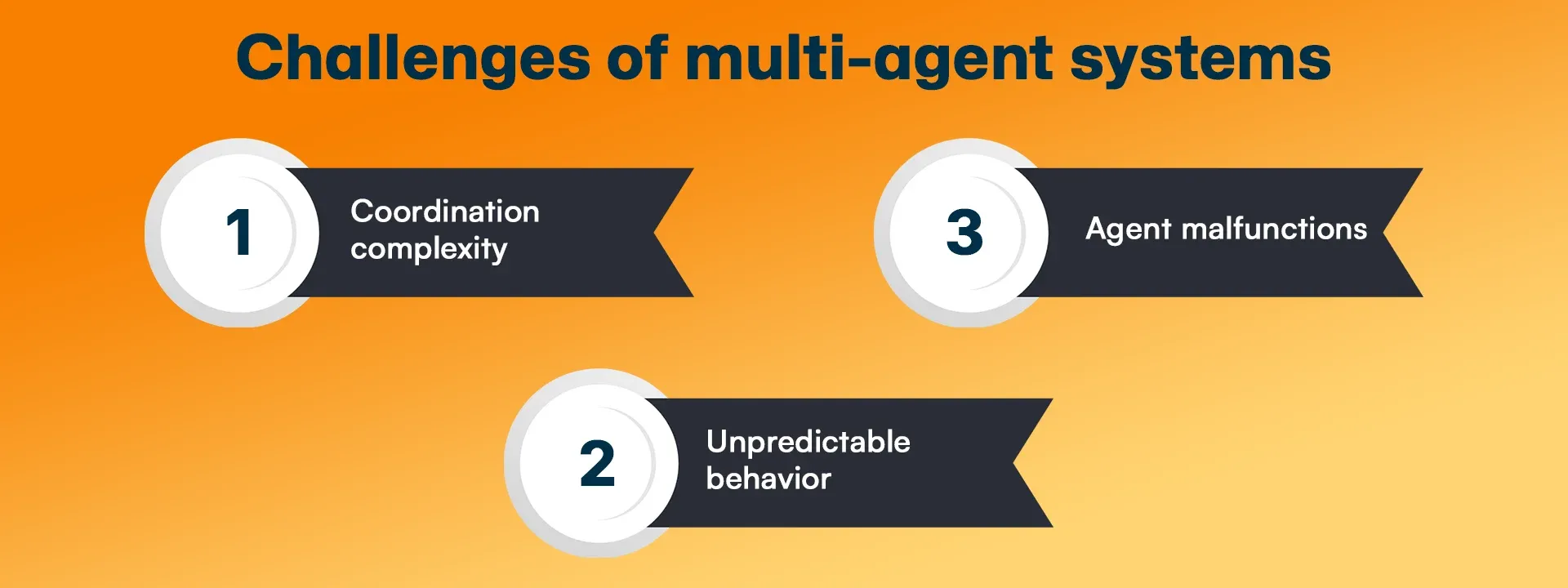
- Coordination Complexity: Coordinating with a single agent is not that difficult, but synchronizing with multiple agents can be tricky.
- Unpredictable Behavior: The agents in a decentralized structure can act unexpectedly.
- Agent Malfunctions: The biggest problem in multi-agent systems is that if a bug or error occurs in one agent, it will spread to all.
Future with AI Multi-Agent Systems
The most special feature of Multi-Agent Systems is that as it evolves on its own, it will also evolve different industries to a great extent. AI Agents help a lot in scaling business and intelligent coordination.
Personally, I like multi agent systems because it is transforming a very critical sector like healthcare, and it will become more advanced in the future, due to which there will be proper coordination between patients, all hospitals, doctors, due to which it will be very effective to identify and treat the disease based on previous medical history and proper diagnosis.
As per the current track record of the multi-agent system till now, transportation, logistics and healthcare sectors will benefit the most from it, and just as there has been a transformation from single agent to multi-agents, similarly, some superior version of multi-agent will also surely come.
Conclusion
Today, Multi-Agent Systems is not just a research or a futuristic concept but has become the backbone of the core infrastructure of today's industries. Multi-agent systems allow businesses to scale their operations further because AI agents greatly support adaptability and reliability. So, whether you are an AI developer like me or a business leader, or a student who is interested in AI, always remember that AI agents will be very useful and impactful for everyone.
I have personally seen Multi-Agent Systems in the customer service operations of Salesforce and in the financial operations of JPMorgan because they make their financial predictions and strategy using AI agents. Apart from this, if you need to deploy custom AI agents or software solutions in your business operations, then you can contact the RejoiceHub firm.
Frequently Asked Questions
Q1. How does a MAS differ from a single-agent system?
A MAS has multiple agents working together or competing, while a single-agent system relies on one entity to handle all tasks.
Q2. Can MAS be used in real-time applications?
Yes, especially with edge computing and efficient communication protocols.
Q3. Are MAS expensive to implement?
They can be resource-intensive initially, but their scalability and efficiency can save costs long-term.
Q4. Which industries benefit most from MAS?
Healthcare, transportation, defense, manufacturing, and supply chain management.
Q5. What’s the biggest risk in MAS deployment?
Poor coordination and lack of safety measures can cause system-wide failures.
